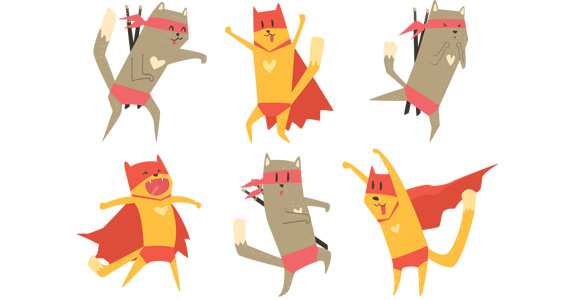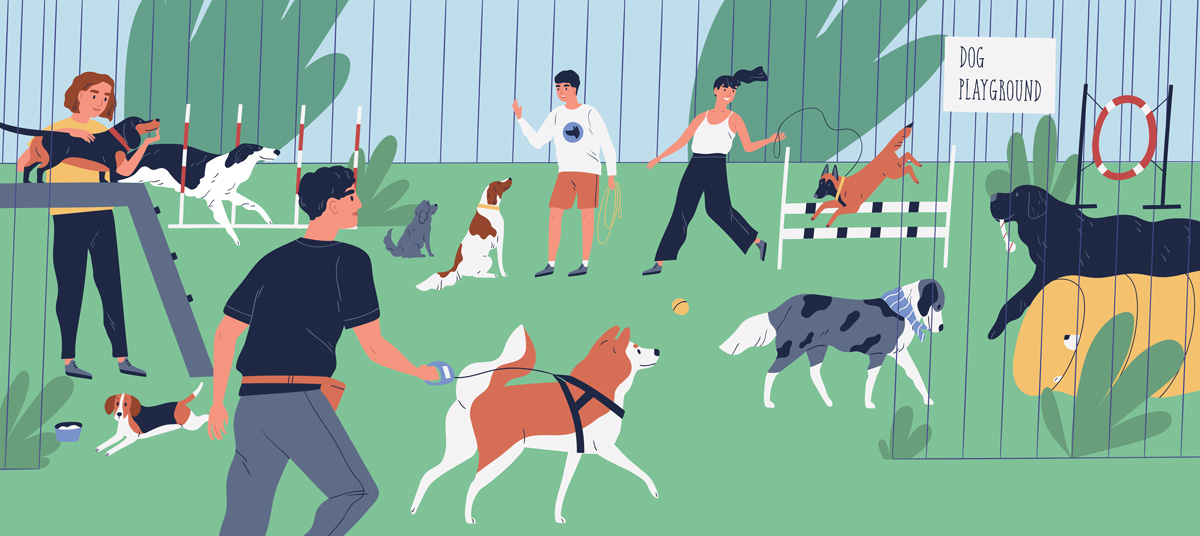The Differences Between Doggie Play And Aggression
by Maria Skorobogatov
“Yay, play!” or “Go away!”
Most dog owners are savvy enough to know the nuances between their companions playful growl, versus one that’s serious. But what about an unfamiliar dog, say, at the dog park? Every day I see well-meaning owners admonish pups for play that’s totally welcome, but on the surface appears to be rude.
Each dog is different in their temperament and upbringing and as such, so is their play style. How well a pup was socialized at that critical 3-to-16-week window to all manner of play, and even the breed itself (herding breeds tend to incorporate herding behaviors such as nipping and growling, for example) are factors that will determine how your furry friend responds to unfamiliar dogs at the park.
I walk a dog who is a very vocal player; he enjoys snarling and barking while bouncing around with other pups. Knowing this, I don’t intervene or edit his play unless other owners look concerned, or the other dog reads his behavior as being threatening. But how do I know he is in fact playing and that his behavior isn’t something likely to escalate into aggression? Is he friend, or foe?
When a dog is engaged in appropriate play, things you want to see are:
Pro Social Behaviors: There are a number of polite cues that dogs will give other dogs when they mean no harm. These include bouncy inefficient movements (very puppy-like, messy movements), wagging, licking, jumping up to access the face, ears back, paw raises, and whining.
To get even more technical, there are even things called “meta-communications” friendly dogs employ to really make a good impression. Movements such as the so called “play face” where dogs appear to be grinning, and the adorable maneuver many owners have come to recognize as the “play bow” where a dog will stick it’s tush high up in the air with its front paws extended, are just some of the visual invitations that should precede play from one dog to another.
Role reversal: An example of role reversal is when dog A chases dog B, and suddenly dog B begins to chase dog A. Back and forth chasing, mounting, scruff bites, barking, etc, are all permissible provided both dogs are equally involved. You want to see loads of roles reversed through out the course of play.
Activity Shifts: The dogs have gone from chasing, to sniffing, to mounting, to body slamming, etc. Lots of different activities are involved in a normal play session, as are numerous breaks.

So what do we know? It’s normal to see all sorts of growling, lunging, mouthing, scruff bites, snarling and mounting during play, as long as you see one or more of the above, and the play is preceded by those pro social behaviors listed. It’s as though the dog were saying “I’m about to bite/body-slam/chase you but my intention is play, wanna join?” Next time you’re at the dog park, see how many instances of the afore-mentioned behaviors you can spot from the dogs around you.
“But wait!” you might say, “I really think my poor butter cup is gonna be eaten by that snarling husky who just won’t leave her alone!” Well, there’s a final test to determine if your pup is enjoying the play or is being tormented by an out-of-control bully. Politely ask the other dog’s owner if they wouldn’t mind holding onto their dog for a moment or two. If Buttercup immediately hightails it outta there in the opposite direction, she likely doesn’t want to engage. If however, she goes right back to the restrained dog and tries to reinitiate play, she’s probably into it.
Now, the absence of most or all of the above body language indicates that your dog simply does not want to play, and should not be coerced into doing so. There are times when some dogs are happiest being on their own and able to check out another dog if they want.
It’s worth noting that polite and easy play doesn’t mean that arguments can’t happen. Any type of arousal whether it’s friendly or not has the potential to escalate into a brouhaha. Hence, intermittent cool-down sessions during the midst of play (the perfect opportunity to practice your recalls!) are a good idea.
Remember, scuffles are ok and a normal part of doggie interactions. Imagine saying to another human that they’re never allowed to raise their voice in an argument, it’s the same idea. You know your dog has bite inhibition and won’t seriously injure another dog if a scuffle should break out (Right? Otherwise, they have zero business being at a dog park), so there’s no need to worry that a snarky argument means you have a Cujo on your hands.
Our advice: Expose your young pup to as many different types of dogs as you can as early as you’re able. This will help ensure that she grows up knowing how to navigate and adjust her play style to match another’s and won’t be easily put off by rowdy doggie play.
You want to look at the totality of actions that comprise your pup’s behavior when assessing play or aggression. Just as a wagging tail on its own doesn’t always mean a friendly dog, a growl doesn’t qualify aggression.
If you have questions or concerns about doggie park social etiquette, please contact us!









